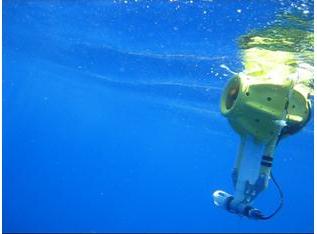AOML/PHOD charters a small boat to measure the Florida Current transport using a dropsonde float. These measurements are used to verify and calibrate the transport measurements derived by monitoring the voltages on an abandoned submarine telephone cable. The dropsonde float is a free falling instrument that records the temperature, conductivity, pressure and average current velocity in a vertical column of water. The instrument is dropped into the ocean at a known position. It descends at a constant rate to the bottom; weights are released on bottom contact, and then the instrument ascends to the surface. The distance between the drop point and the point were the instruments first surfaces, represents the total vertically accumulated drift during the period of descent and ascent.
The original dropsonde float (see figure) is a 60 inch long x .25 inch thick wall glass tube, Glass is a well-proven material for deep ocean instrument housing. The instrument is equipped with a GPS receiver, radio beacon, temperature sensor and pressure gauge.
The new generation of dropsonde floats (see left Figure) are equipped with a self-contained conductivity, pressure and depth sensors that are interfaced to a 13-inch glass sphere. The glass sphere contains a micro-controller, a GPS receiver, 900 MHz radio transceiver and supporting electronics. The sensors on the instrument output high accuracy data: 0.0002 S/m conductivity, 0.002 degrees Celsius, and 0.02 full-scale pressures. They also have a very fast response time: 5.0 cm at 1 m/sec for conductivity, 150msec for pressure and 25 msec for temperature. The conductivity is measured without the need for a pump (no electrodes). It also has six 12-Bits A/D channels and it is capable of outputting digital data via a direct serial line or wireless RF-link.

